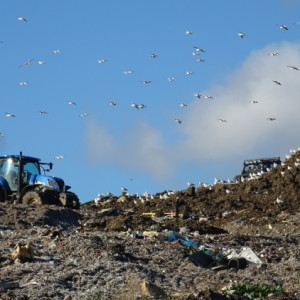This is landfill
And there's a lot more to it than simply brushing stuff under the carpet!
The company for whom I now work used to be a household name in cement, and because of that history they own a lot of exhausted quarries. Once upon a time expired quarries were simply filled up with garbage, but as anyone who has ever cleaned out the bottom of their domestic waste bin knows, garbage sitting on garbage produces a nasty icky syrupy black liquid now called leachate. If the base of the quarry is not lined with something impervious then the leachate will seep into the bedrock, and eventually into water supplies, so these days more care needs to be taken.
When all the valuable chalk has been extracted from a chalk quarry there will be several metres of clay underneath, so that is excavated and piled up on one side out of the way for future use. Then the base of the quarry is lined with an impervious material, which is covered with a layer of rocks, then sand and then felt. It is contoured in such a way that liquids will collect at a known location and is raised at the sides to prevent overflow. Imagine the brown plastic tray ubiquitous in boxes of chocolates, it's a little like that. Each “cell” might cover approximately an acre, maybe less.
To begin with only “fluffy” waste is tipped in, nothing likely to puncture the impermeable base of the cell. When that is deep enough anything can be chucked in, but if there is any possibility that asbestos is included then the cell needs to be labelled as an asbestos hazard for all eternity.
All day long trucks arrive to deposit waste, which is tipped and driven across by heavy vehicles with knobbly wheels to compact it as much as possible, and towards the end of the day a coating of clay is spread over the surface to prevent odours and to stop the garbage from blowing away.
Meanwhile icky black leachate is collecting at the base of the cell which needs to be pumped out and dealt with, so leachate wells are drilled and the nasty juice is collected in treatment tanks.
Sanitising leachate is fairly expensive and produces no revenue.
A 40-tonne truck arrives full of garbage. It is weighed on its way in, offloads, and is weighed again on its way out. For every tonne it offloads the Govt. receives £85 in “landfill tax” and the site receives about £35 to manage it.
At this moment I should also mention that while a landfill site is operational it is under constant scrutiny from the Environment Agency, and also Her Majesty's Revenue & Customs. The involvement of the EA is not difficult to comprehend, but the HMRC needs to know at all times what items of value are being stored where; so we have a pre-designated “tax free” area where we may stockpile pipework and pumps and well-heads, but as soon as any of those items are removed from that sanctuary, they become taxable assets.
So far the Govt. is making far more bob than we are wouldn't you say? And not getting smelly and muddy in the process either.
But here comes the fun.
This stinking filthy mess also produces combustible gas, and so we have another network of pipes bringing that to our power plant. The gas runs engines which make electricity which we sell back to the National Grid. And because it is such a small operation in comparison to all the other large power stations in the country, it can be a lot more flexible about gearing up or shutting down.
So, when a Royal Wedding, or an eagerly-awaited finale to a thrilling TV series, or a high profile sporting event is scheduled to be broadcast on TV, the local grid asks us to provide the necessary extra boost for that moment when the nation puts the kettle on simultaneously. And that is where riches come from landfill.
But I should add, that even after a landfill site has been exhausted, capped, planted over and restored to a mound of natural beauty, we still have a duty of care for the next sixty years.



Comments
Sign in or get an account to comment.


